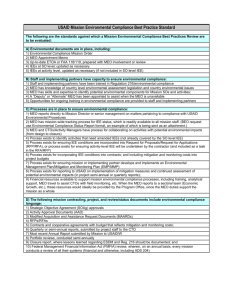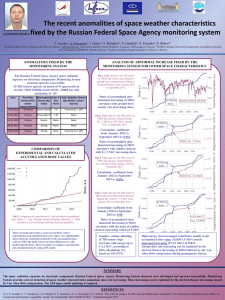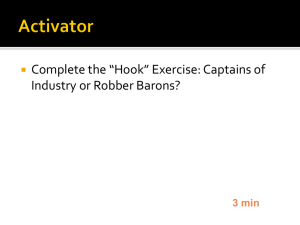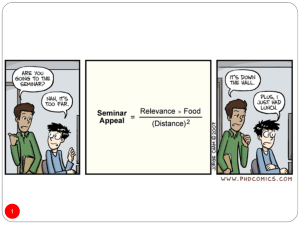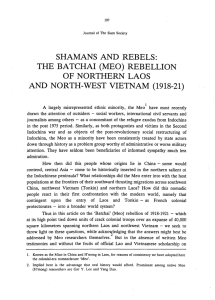Civil Rights Impact Analysis For Information Technology
advertisement
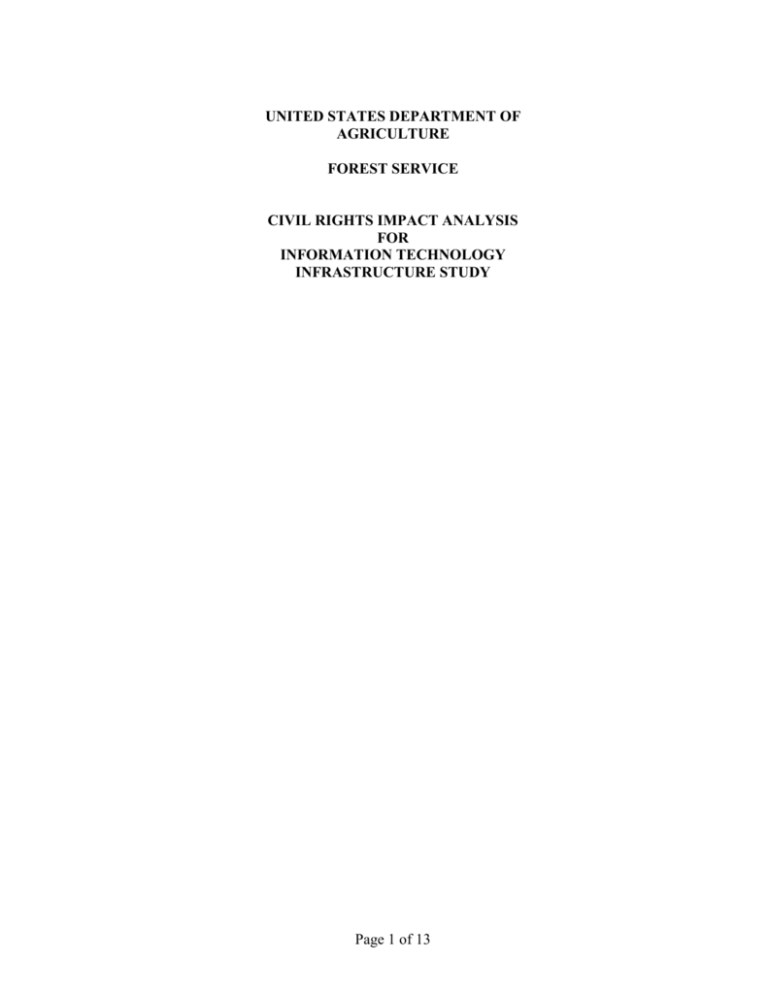
UNITED STATES DEPARTMENT OF AGRICULTURE FOREST SERVICE CIVIL RIGHTS IMPACT ANALYSIS FOR INFORMATION TECHNOLOGY INFRASTRUCTURE STUDY Page 1 of 13 Certification of Civil Rights Director As the Agency’s principal Equal Employment Opportunity (EEO) official, the Director of Civil Rights (CR) is responsible for administering a full range of EEO and Title VI Programs. The Director provides advice and technical guidance on CR matters to the USDA Forest Service Chief and other Agency management officials. This is certification that the Director of CR was actively involved in the planning and implementation of this IT study. /s/ Kathleen Gause KATHLEEN GAUSE Director, Civil Rights Date: 4-9-2004 Reviewed by: /s/Douglas R. Nash Douglas Nash Asst. Director, WO IRM Staff Date: 4-9-2004 /s/ Roland L. Copstead Ronald Copstead IRM Director, PNW Station Date: 4-13-2004 /s/ Eric Plimmer Eric Plimmer NFFE, FSC Representative Date: 4-12-2004 /s/ Tina Hougan Tina Hougan Management Analyst, Region 6 Date: 4-12-2004 /s/ Thomas Baughman Thomas Baughman Equal Employment Specialist Date: 4-9-2004 /s/ Robert Ragos Date: 4-9-2004 Robert Ragos Equal Opportunity Administrative Assistant Prepared by: /s/ Jerome Romero Jerome Romero Equal Opportunity Specialist Page 2 of 13 Date: 4-9-2004 TABLE OF CONTENTS Certification by Civil Rights Director………………………………… page 2 Section 1. Description of Proposed Action ……………………… page 4 Section 2. Data Gathering / Employee Development …………… page 5 Section 3. Situation ……………………………………………… page 6 Unfavorable Impacts………………………………….. page 6 Favorable Impacts……………………………………... page 7 Section 4. Alternatives and Mitigations…………………………... page 8 Section 5. Net Civil Rights Impacts……………………………… page 10 Supplemental data used in analysis was not included because of document size. Data is available upon request. App. 1.A. All Forest Service in Series Affected by IT CS Study According to MEO Data Call / Numbers. App. 1.B. All Forest Service in Series Affected by IT CS Study According to MEO Data Call / Percentages. App. 2.A People Reporting 11% or more of their Work Under Study / Numbers. App. 2.B People Reporting 11% or more of their Work Under Study / Percentages. App. 3. Age Distribution of employees with 11% or more of Their work under study vs. Age of employees in IT job series. App.4. Job Series and RSNOD Groups with Potential ………. Disproportionate Impacts. Page 3 of 13 page 12 Civil Rights Impact Analysis Award of IT Infrastructure Study 1. Description of Proposed Action With the award of the Information Technology (IT) Infrastructure Competitive Sourcing (CS) Study to a service provider in the spring/summer of 2004, Forest Service IT services will be provided by either a government Most Efficient Organization (MEO) or an external service provider. In both cases the new organization will be centralized reporting to the Forest Service (FS) Chief Information Officer (CIO) rather than local line officers as the current organization is structured. In addition, services will be provided and governed by contract service levels and incentives. This will be a significant change from the traditional highly decentralized service-wide IT organization and operations where performance is typically only measured locally through individual performance reviews. The outcome will drastically reduce FS IT staffing by 55% should the MEO be selected to a 90% reduction if a private contractor is selected. The IT Infrastructure Study began in February 2003 (see FS Competitive Sourcing Study CRIA and Persons with Disabilities Supplemental CRIA ) and is scheduled for award by August 19, 2004 at the latest. This program area was selected for study because FS IT services and tools are sometimes duplicative and inefficient, making this a good candidate for competitive sourcing study or reorganization leading to reduced costs, greater efficiency and improved service. 1157 Forest Service employees are potentially affected as a result of the IT study. Forty-nine job series have been identified as falling within the study; series GS-2210 impacts the largest number of employees (583). Other potentially affected series include GS-201 (2), GS-203 (1), GS-301 (36), GS303 (28), GS-304 (2), GS-305 (4), GS-318 (4), GS-326 (20), GS-332 (17), GS334 (1), GS-335 (100), GS-341 (4), GS-342 (17), GS-343 (6), GS-344 (1), GS391 (116), GS-399 (3), GS-401 (13), GS-404 (2), GS-460 (11), GS-462 (29), GS-482 (1), GS-501 (3), GS-503 (1), GS-525 (1), GS-560 (3), GS-801 (4), GS802 (3), GS-810 (3), GS-855 (6), GS-856 (85), GS-1001 (12), GS-1082 (1), GS-1101 (12), GS-1102 (1), GS-1105 (1) GS-1170 (2), GS-1301 (1), GS-1371 (5), GS-1515 (1), GS-1530 (1), GS-1550 (2), GS-2210 (583), GS-2299 (9), GS- 2604 (2), GS-2805 (1), GS-5716 (2), WG-4102 (1), WG-4749 (1). Four series impact roughly 885 employees (76%) in the IT study. Series are identified below: GS-2210 (583), GS-391 (116), GS-335 (100), GS-856 (86). The remaining 45 series make up the other 24% being studied. Impacts appear to be across all ethnic groups, gender and people with disabilities. Page 4 of 13 Refer to Appendix 1A/1B – All Forest Service in Series Affected by IT CS Study according to MEO data call, and Appendix 2A/2B – People Reporting 11% or more of their Work Under Study, for tables identifying the affected IT workforce by series and RSNOD groups. 2. Data Gathering/Employee Involvement The A-76 Competitive Sourcing process is highly prescriptive and structured. It provides limited opportunity for broad involvement of employees in the process or potential outcomes. The process is designed to follow standard contracting and commercial practices of objectively defining requirements, soliciting offers, evaluating bids, and selecting the best offer based on cost, technical merit, and potential for success. The competition typically results in the selection of the bidder whose offer will provide the best service with minimal staffing and high efficiency at the lowest cost. While impacts on existing government IT staff are not considered, specification of services are given full consideration in the process of selecting a service provider. Given the constraints on employee involvement, we have provided a number of opportunities for employees to provide feedback and get information on the study. More than 100 subject matter experts (SMEs) were consulted and were involved with the Performance Work Statement (PWS) core team over a 6month period to prepare specifications for this solicitation. More than 20 additional SMEs were involved with the MEO core team (independently “firewalled” from PWS and Source Selection Board (SSB)) to create the proposed government bid. The SMEs and core teams were drawn from all levels across the breadth of field offices within the agency. At the national level, the Deputy Chief of Operations established a communications team that provides regular updates on the study and answers to employees’ questions via newsletters, official correspondence, and other communications tools. The Competitive Sourcing website (http://www.fs.fed.us/business/it-cs-study/) is another tool that was established at the start of the study and has been used extensively to share information and get feedback from employees. Regions and Stations established local CS teams to disseminate information, interact with employees, and to collect and provide input to the national study. During the development of both the Performance Work Statement (PWS) and MEO proposal, representatives from a cross section of the organization participated on both of these teams and helped develop the final products. Various data calls from both teams also sought technical and organizational data from employees, SMEs, and agency leadership. Finally, senior FS and IRM leadership, including 4 members of the National Leadership Team participated directly with PWS, MEO, or Source Selection teams, solicited input and shared information on the study with the rest of the National Leadership Team, the Administrative Management Council, labor unions, and other key FS organizations. Page 5 of 13 3. Situation FS IT Infrastructure functions were selected for study under the competitive sourcing process because of the opportunity to increase efficiency, improve service, minimize duplicative staffing and operations, and reduce costs. Whether a commercial service provider is selected or the contract is awarded to the MEO, these opportunities can be realized. The transition to the new service provider will occur over a very short timeframe and will impact a large number of FS IT staff with changes in job duties, duty stations, or job loss. The rest of the FS workforce will be impacted in how they obtain services and the change in relationships they established with local IT employees. The probability also exists that non-IT staff will be impacted to the extent that Reduction-in-Force (RIF) is likely to be used to bring about the necessary personnel reductions. External organizations and the public will also see a change in that technology is the common denominator in how these groups interact with FS employees. See the HRM IT Implementation Plan and Recommendations dated March 30, 2004 on the transition process and HR tools that will be used. The new IT organization will be led by the by the Residual Organization (RO) that includes the CIO’s office, WO IRM functions that were not included in the IT Infrastructure Study, and those functions determined to be Governmental In Nature (GIN). The RO will have approximately 110-120 positions. The MEO or external service provider organization will report to the RO. The MEO has 567 positions during the first year decreasing to 475 thru attrition by year 5. The MEO will be filled by FS IT employees, if it is selected as the service provider. With either an MEO or commercial service provider selection, transition will occur over a 90 day Phase-In period and will require the transition not only to a new IT services and operating approach but transition of IT employees out of their current positions into either new positions in the MEO, placement elsewhere in the FS, or RIF’ed from federal service. If an external service provider is selected transition to the new technology services will also occur over a 90-day period. Unfavorable Impacts The following unfavorable impacts will occur with the selection of a new service provider: Significant reduction in the overall IT workforce. An MEO selection could potentially result in a reduction of as many as 55% of employees. With a contractor win the potential reduction could be far higher with up to 90% of the employees under study losing their jobs. Page 6 of 13 Higher reduction of GS-9 and lower graded positions – The RO and MEO have mostly higher graded positions because of the increased scope of work, requirement for higher skill levels, and use of more complex technology to automate functions currently done by lower graded employees. Larger impacts on minorities, women and people with disabilities - IT work, like most administrative series, generally has a proportionately higher number of minorities, women, and people with disabilities doing the work as compared to other job series. Change in duty locations, supervisors, and work environments Change in career/profession path Change in commute pattern to and from the new work-site, although the MEO proposal allocates a significant number of positions to virtual or remote locations by employing technologies that allow the scope of employee’s work to be effective over a large number of remote offices. Changes in community services/medical services Change in economic status Merit promotion – If merit promotion is used to fill positions in the MEO no preference will be given to employees based on longevity or veterans preference. Changes to customer base – Employees will have to seek IT service in a different manner than is customary in the FS, most likely thru the single point of contact helpdesk—the End User Support Center (EUSC) --or other centralized service as opposed to getting support directly from local IT staff. Line officers will no longer manage IT staff directly. Favorable Impacts Favorable impacts with a new service provider are: Merit promotion will be used to fill the MEO if the government is selected. Using merit promotion to fill positions in the MEO will make the process more equitable to all classes of employees in competing for jobs in the new organization. The one exception is the Washington, DC competitive area where merit promotion cannot be used to fill positions because of RIF and competitive area rules. Additional explanation of this exception is available in the IT Recommendations and Pre-Implementation Plan. RIF procedures will be used to fill positions in the Deputy Chief for Operations Area located in the Washington, DC. Higher graded positions provide some opportunity for promotions. The MEO and WO use a significant number of virtual positions. Opportunities for small businesses if an outside service provider is selected. Page 7 of 13 4. Alternatives and Mitigations In developing the preferred approach to filling positions in the new IT service organization if the MEO is selected, 6 alternatives were considered. Five alternatives were considered in the event of a contractor award. See the HRM IT Implementation Plan and Recommendations for complete details on the alternatives considered. Elements used to evaluate all alternatives included: Ability for the agency to meet timelines required by the solicitation and competitive sourcing process Ability to offer opportunity and options to employees Ability to match skills and duties Ability to protect employee rights Ability to provide consistency in process and rule application so that employees receive equitable treatment Ability to retain an appropriate level of local line officer decision space on local placement opportunity (for positions outside the study) Budget implications Risk mitigation Mitigations The competitive sourcing process offers little flexibility in mitigating impacts. Still, there are a number of opportunities to mitigate the outcome of the decision: Strategic Use of HR Tools - Various workforce management authorities or tools requested and sought by the Agency (i.e., WRAPS, Voluntary Early Retirement Incentives, Voluntary Separation Incentive Payments, etc., as appropriate) will be used to facilitate the retention and placement of employees during the transition to the MEO or external service provider. Career transition training and counseling - Several Career Transition Planning Workshops have been held (with more being planned) across the service, to assist employees to pro-actively deal with potential career changes. These sessions included multiple small-group workshops on retirement planning, how to write resumes, interview techniques, RIF/WRAPS rules, Town Meeting concerns to address questions and answers, motivational speakers, etc. Both the Washington Office and field units have provided training. Employee Assistance Services - Some units have used their Employee Assistance Contractor to conduct transition sessions with affected employee groups to provide additional support. Extensive communications of new services – A communications team that is directed by the Deputy Chief for Business Operations is developing tools to communicate the competitive sourcing decision, timeline, how jobs will be Page 8 of 13 filled, and how employees will get services from the new organization. Information will be shared widely and often to ensure employees have the latest and correct information. External employment opportunities - Experience with competitive sourcing in other agencies has shown that in many cases where employees are displaced by competitive sourcing decisions to contract out a function they are employed by the firm that is awarded the contract for this function. This is especially true for Information Technology function where private industry salaries can be equal to or greater than federal government salaries. In order to facilitate this occurring, competitive sourcing solicitations require the use of a “Right of First Refusal” contract clause, which requires successful contract bidders to first offer positions to qualified displaced federal employees when they hire new employees. Merit promotion – Merit promotion will be used to fill the MEO if the government is selected. This will provide more opportunities to women and minorities since they typically have less time-in-service and less retention rights. Merit promotion levels the playing field. WRAPS process - The National Union/Management Partnership completed negotiations modifying both the Workforce Restructuring and Placement System (WRAPS) and RIF Articles of the Master Agreement. The Servicewide WRAPS process facilitates lateral and reduced grade placements, and includes a database so that employee qualifications and personal preferences can more reliably be matched with vacancies. WRAPS also provides the opportunity for Units at all levels of the Forest Service to develop a local “PreWRAPS” process to maximize placement and retention on their individual Unit. Use of grade and/or pay retention - Grade and/or pay retention will be applicable in most (if not all) placement situations throughout this transition process. Retraining – The USDA Career Transition Assistance Plan (CTAP) provides the authority to expend agency funds for the purpose of retraining surplus employees. Transition Planning – Implementing the new organization and the processes to move staff into it is being guided by a transition plan developed at the national level with input from field stakeholders. By having a single standardized and documented transition approach that is centrally monitored and managed will help ensure that a consistent, coordinated, and fair approach is used to staff out and implement the new organization. Ongoing monitoring effects of implementation - Local (Region and Station) Competitive Sourcing implementation will include periodic data collection of Race, Sex, National Origin and Disability (RSNOD) data (categories) for assessment of local impacts, mitigation, and decisions throughout the process. Opportunities for private sector and small businesses - Even though competitive sourcing decisions may result in a reduced federal workforce, these same decisions can result in increased employment opportunities for those in the private sector job market. Through the use of Small Business Page 9 of 13 5. Administration programs a portion of these employment opportunities can be made available to small disadvantaged, minority-owned and women-owned small businesses. Reasonable accommodation request policy and procedures – Regions/Stations/Area (RSA) reasonable accommodation request policy and procedures are in place to provide RSA guidance, support and direction regarding retention and placement of persons with disabilities, in accordance with EEOC Management Directive 715. Reasonable accommodations considered on a case-by-case basis - Local reasonable accommodation requests from employees with disabilities will be considered on a case-by-case basis to facilitate and reduce impacts of decisions resulting from competitive sourcing decisions. Training on the Competitive Sourcing process – Human Resource (HR) and Civil Rights (CR) employees have attended training sessions about competitive sourcing (OPM A76 circular) and RIF regulations so that they are able to counsel employees as to their options. Some units have conducted one-on-one counseling sessions with affected employees, at the employee’s request. These sessions have included retirement counseling, review of their Official Personnel file, career counseling, and other information to prepare employees for job changes whether stay with the government and work in jobs that result from A76 studies, or not. Use of End User Support Center (EUSC) - Persons with disabilities will benefit from the resources available through the EUSC (such as TTY devices, Same-Time collaboration software, and remote management tools) that facilitate communication with people with disabilities. Use of excepted appointments - The Agency is encouraging creative use of the excepted service appointments as a tool to allow employees with disabilities more time to transition, e.g., 700 hour excepted appointments may be given to a person with a severe disability without competition. Virtual positions – The RO and MEO both have a significant number of virtual positions. The use of virtual positions allows employees selected for these positions to remain at their current duty station thereby minimizing the impact on their families and ties to the local community. Virtual positions also result in lower cost to the government in transfer of station and relocation costs. Net Civil Rights Impacts Through the Civil Rights Impact Analysis it has been determined that minorities, women, and people with disabilities will be affected. Potential impacts to overall permanent, term/temp employees based on Race and/or National Origin identify disproportionate impacts for White Females (WF), Black Males (BM), Black Females (BF), Hispanic Females (HF), and American Indian Females (AIF). Disproportionate Impacts are determined to occur when the percentage of impact for a specific Race, Sex, National Origin or Disability (RSNOD) Page 10 of 13 group is greater than the group’s percentage in the workforce. In this case comparison was made between those series reporting 11% or more of their work under study compared to the same series as a whole regardless of the percentage of work being studied and also to the current FS Permanent and Temporary workforce numbers. Potential impacts to overall permanent, term/temp employees based on Gender identified 568 positions occupied by males and 589 positions occupied by females, for a total of 1157. Disproportionate impacts are anticipated for females when compared to all female employees in the same series as a whole. Potential impacts to overall permanent, term/temp employees based on Disability identified 101 individuals affected. This is 9% of the total population under study. This is compared to 6% of all Forest Service employees in the same series being studied, thus a disproportionate impact is likely for people with disabilities. Potential impacts to overall permanent employees based on Age (40 years and older) identified disproportionate impacts (84%) for those employees reporting 11% or more of their work under study. This is compared to all forest service employees (75%) in series affected by the IT study. Impacts to permanent employees (40 years and younger) were identified, however, impacts were not disproportionate (Appendix 3). *Note: Numbers for Terms and Temps were not included in the overall numbers for the comparison dealing with age. Potential impacts to overall permanent, term/temp employees based on Series identified that all RSNOD groups would be disproportionately affected as a result of the study (Appendix 4.) **Note - White Male (WM), White Female (WF), Black Male (BM), Black Female (BF), Hispanic Male (HM), Hispanic Female (HF), Asian Pacific Male (APM), Asian Pacific Female (APF), American Indian Male (AIM), American Indian Female (AIF). 6. Monitoring and Evaluation The Competitive Sourcing Team will monitor and assist in analyzing and validating costs and/or savings associated with the mitigation measures and IT study as a whole. Page 11 of 13 Appendix 4 Job series and RSNOD groups with potential disproportionate impacts Series (GS) 2210 391 335 856 201 203 301 303 304 305 318 326 332 334 341 342 343 344 399 401 404 460 462 482 501 503 525 560 801 802 810 855 1001 1082 1101 1102 1105 1170 1301 1371 1515 RSNOD Groups WF, BM, HF, APM, AIF WF, HM, APM, WF, BF, HF, APM APF, AIM AIF BM, HF, APM, APF, AIM, AIF WF AIF WM, BM, APF, AIF WM, BM, HF, AIF WF, HF WF WF WM, BF, HF WF, HF, AIF WF WM, WF WM, WF, HF WF, BM, BF WF Temp WM WM, HF WM WF WF WM WM, HM WM WF WF WM WF, HM WF WF, BF, HF WF WF WF, BF WM, HF WM WM WF, HM WF AIF WM, BF, HM, APF HM WM WM WF, HF WM Page 12 of 13 WF WM WF 1530 1550 2299 WM WF, BF, HM 2604 2805 5716 AIF WM WM Series (WG) 4102 4749 Page 13 of 13 WF, HF, APM
